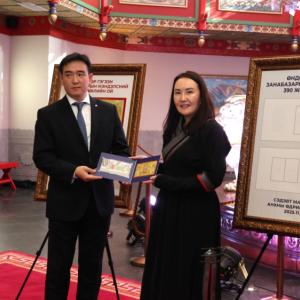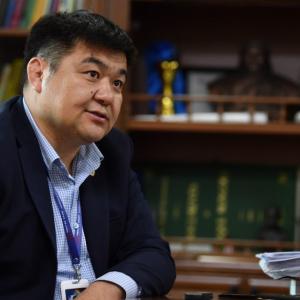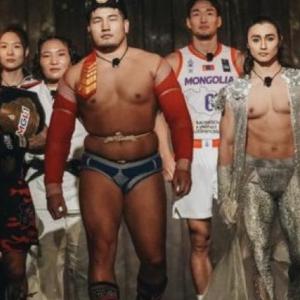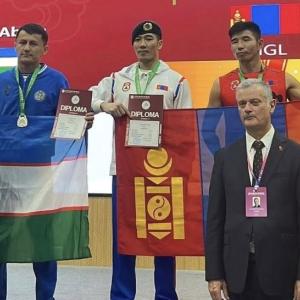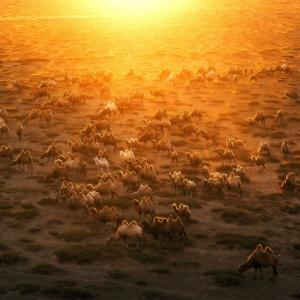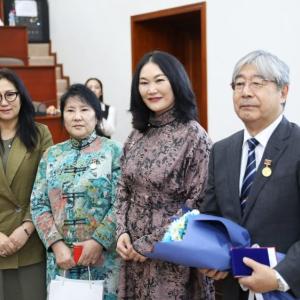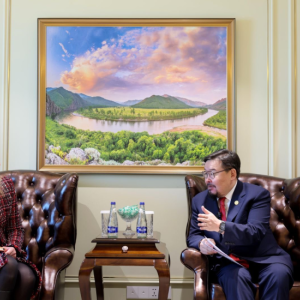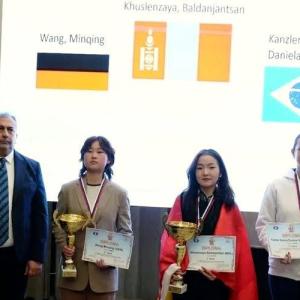A Guardian of Tradition: Exploring Mongolia’s Timeless Art of Long Songs with Enkhbaatar Gankhuyag
Interview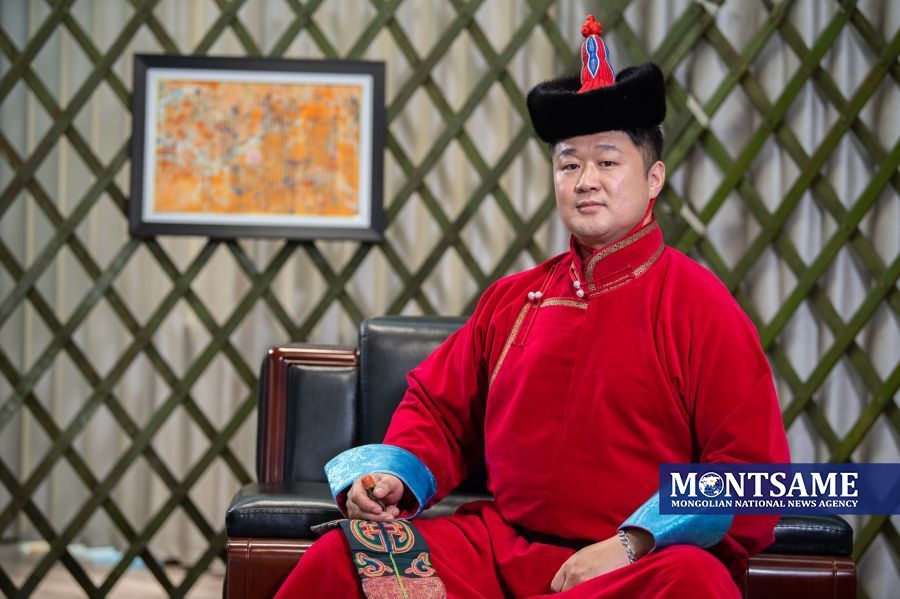
Ulaanbaatar, April 22, 2025 /MONTSAME/. In a rapidly modernizing world, preserving heritage has become both a challenge and a responsibility. MONTSAME National News Agency spoke with a Mongol long-song singer Enkhbaatar Gankhuyag, Honored Artist of Mongolia, about Mongol long songs, which are recognized as intangible cultural heritage by UNESCO. In this revealing conversation, Mr. Enkhbaatar shares insights into the essence of Mongol culture and the profound bond between music and tradition.
You once mentioned that a traditional Mongol long song “Alia Saaral” (Playful Grey [A Lively Steed]) would be your constant companion as a young boy. Would you please share your memories of your first encounter with the long song?
Indeed, I was around 15 or 16 years old when I first learned to sing “Alia Saaral.” I remember riding my horse and feeling an undeniable pull towards the song. Perhaps it was the lyrics that captivated me: I wanted to ride Alia Saaral, my steed, But it took off with another herd, with speed, I wanted to go stay with my sweetheart, But the kids keep teasing me, oh what a bother! At that time, of course, girls would interest me naturally. I found the song intriguing and even a little humorous. The lyrics seemed to read my mind too. So, whenever I was on horseback, I would involuntarily sing “Alia Saaral.”
Could you please recite a part of “Alia Saaral”?
Certainly. Many legendary singers, whom we call the “Singers of the Golden Age,” have beautifully rendered “Alia Saaral,” in their own unique ways. The song is sung in different melodies. However, the Khalkha melody is the most popular one, though even within that, there are varieties. For instance, Tsoodol Soli’s rendition is more refined, while Nyamlkhagva’s interpretation is more tender. Imagine someone galloping across the steppe after having half a tagsh [Mongol wooden bowl] of “shimiin arkhi” [traditional Mongol light alcoholic beverage made from cows' milk] in the crisp autumn evening. Let me demonstrate it in the style of Tsoodol guai. His style is distinctive, starting from a very high note, which is quite rare, but it has a unique charm. Nyamlkhagva guai’s version is much different. He begins with lower notes, almost as if smoke is slowly rising. Interestingly, they are both from Uvurkhangai aimag, and yet their styles are so different… I feel a tempo of pulls and pushes, though very stately. But with Tsoodol guai, it is a different style, isn’t it? He’s deliberately leaving something behind to pique your interest. It is amazing to see how performers can have completely distinct approaches.
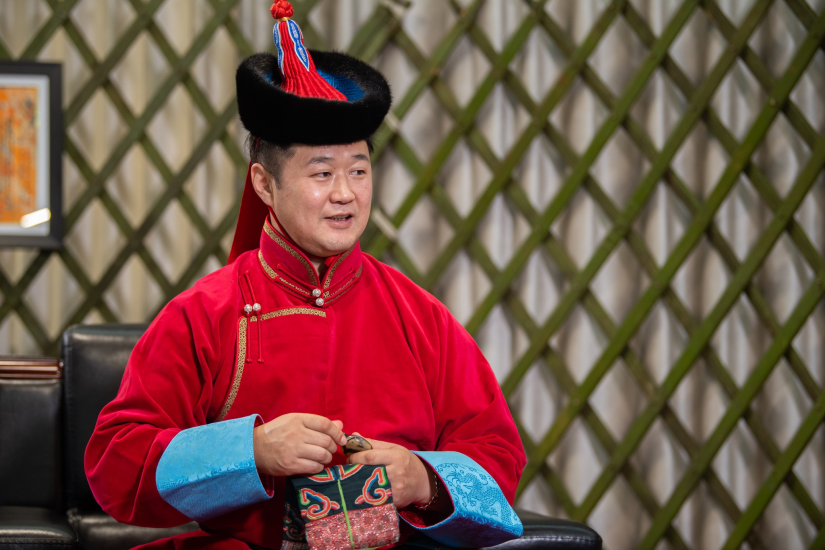
In the famous Mongol film “Tungalag Tamir” [The Crystal Clear Tamir], the protagonist Tsakhiur Tumur sings “Erdene Zasgiin Unaga” [Foal of Erdene Zasag] while riding a horse. You mentioned earlier that you would sing “Alia Saaral” when you were younger. What song would you choose to sing now?
These days, I am particularly drawn to the magnificent song “Nariin Saikhan Kheer” [Slender Bay Horse]. Whenever I visit the place I was born, I feel obliged to sing it. I was born in the countryside, where riding horses is second nature to us. I often ride a horse freely in the endless Mongol steppe, singing out loud. Just like in “Tungalag Tamir,” where Tsakhiur Tumur says, “The song “Erdene Zasgiin Unaga,” my homeland, and my horse are my companions,” I feel that way too. In fact, long melodies come from the highest energy within the human body, and that’s why long songs are sacred and undeniably alive.
We know that long songs have long, drawn-out melodies. But the word "long" carries another meaning. Could you please explain it?
Some people ask if long songs actually have lyrics. They even think they are just vocalizations like “aa, ee, ii, oo.” Some describe them as songs performed by the elderly. Yet, every single word in a long song carries deep philosophical meaning. It is, in essence, a refined and timehonored form of song. Rooted in the Mongolian language and traditions, it carries long, flowing melodies while embedding deep philosophy and thinking within its lyrics. This is a profound wisdom in itself.
Some scholars suggest that the term “long song” has ancient roots…
Indeed, long songs are believed to have thrived back in the Hun Empire. It is an illustrious and inexhaustible heritage of the Mongols.
There are songs, such as Italian Serenade or Sōran Bushi [Japanese fishermen’s song] that are considered to have ancient origins. So, when did our traditional Mongol long song originate?
It is difficult to pinpoint an exact date. While I would not say long songs have been around since the dawn of humanity, I do believe they began to take shape and evolve when people first started riding horses and domesticating them. Over time, these songs continued to develop and refine, passing through the ages and becoming what we know today.
Singing long songs requires a special technique and discipline. Are there any special rules or orders regarding when, where, and how they should be performed?
Absolutely! There is a certain discipline that must be followed. There were unique Khalkha schools of long songs such as Khardel Wang, To Wang and etc. To Wang’s school meticulously trained long-song singers from a young age. They were taught from basics to brilliance, including mastering their voice and adapting to even seasonal changes. This culture was passed down by the great singer Damchaa Seserjaa, who taught Sharkhuukhen Chuluunbaatar guai. Ms. Sharaa was the last to be trained in that school. Sadly, it seems there is no one left to inherit this culture from Sharaa guai.
These schools were very practical, with advice on every detail - how to soothe a sore throat with wild gentians [medicinal herbs]. For example, they taught proper etiquette for long-song singers. Today, people are discussing who can qualify as a long-song singer. It seems that only those who have mastered this culture or school can truly be considered long-song singers. Eventually, such masters would become national heritage. The one who has mastered the techniques and skills, or these schools, can be regarded as a genuine long-song singer.
Truly interesting. Given that you graduated from the Mongolian State University of Arts and Culture as a long-song singer, you must have taken classical art classes too. Nowadays, singers from all over the world perform operas. How do you see the difference between a long song and an opera?
My teacher used to say, “When performing long songs, never force your voice. Sing with your natural timbre, as if you were speaking. In that case only, the true meaning of “folk” and “traditional” would stand out. Otherwise, any sound can be imitated easily. In contrast, Western opera evolved to project the voice in a classical manner, studying oral cavity and voice intensity to carry sound over the farthest distances. Long songs, on the other hand, are traditionally performed in smaller, communal settings, feasts, where a singer is surrounded by a close circle of listeners. A long-song singer narrates myths or shares folklore through a song.” He often reminded me that this close-knit nature of performance must not be abolished at all. So, this is the main difference between a long song and an opera.

In the history of modern rock and pop music, the German band “Enigma” was the first to incorporate long songs with rock and pop, in collaboration with the legendary Mongol long-song singer Nergui Adilbish. Personally, I think such projects would greatly appeal to younger audiences. What would you say about such cross-genre presentations?
I wouldn’t call myself stubborn, but I am of a more conservative nature, and am loyal to the traditional Mongol long song. I reflect on not distorting the art of our ancestors with the everlasting attributive “Mongol,” and preserving this art in its original spirit. There must be many people with such a heart and thoughts. Of course, many people are exploring ways to combine long songs with different rhythms and genres, but I feel that such fusions can be short-lived. Most importantly, the precious essence of the traditional Mongol long song should not be diluted but be preserved in its authentic form.
When collaborating with “Enigma,” Ms. Nergui Adilbish beautifully performed the long song, nothing was modified. The band later added background music in postproduction, creating a unique sense of synergy…
It is said that “Enigma” invited her into the studio to sing her traditional Mongol long song as a cappella. So, she sang it, and left the studio. Afterward, the band added their music in the background, and released it. I heard that Ms. Nergui herself later said that it sounded very unique and remarkable at that time.
You mentioned earlier the importance of preserving and carrying forward traditional long songs. Researchers have found that there were about 6,000 long songs, though only around 60 have become widely known…
It is true that people often complain about the lack of new long-song singers emerging today. In fact, true long-song singers are born, not trained. One thing I’ve been reflecting on is how the rise of stage arts and indoor training may have affected the development of long-song singers.
In the past, there was a rigorous training regime known as Shavi Surgalt [Home schooling], where students studied outdoors, climbing mountains, breathing fresh air, and drawing inspiration directly from nature. This type of training is in high demand right now. Today, formal classroom training seems to have replaced this, and I wonder if that shift is why we no longer see as many new long-song singers.
Are you implying that it’s difficult to instill the authentic spirit of long songs in students within a classroom setting?
Exactly. A person falls in love with INTELLECTUAL HERITAGE OF THE MONGOLS Mongol Long Song 102 | MONGOLIA TODAY something when they see it firsthand. If you gaze upon a beautiful horse or breathtaking landscape, you naturally feel an inner melody. But when you try to summon those feelings within the confines of four walls it’s hard to capture that same authenticity and uniqueness.
Opera singers often talk about the immense pressure they experience while performing. Do you feel similar pressure when singing a long song? Also, the elders and musicologists note that it used to take up to three days to fully perform a traditional long song. What is the longest time you have ever spent performing one, and which song was it?
My experience with that is very much rooted in the “Shavi Surgalt” [Home schooling]. At Mongolian traditional weddings and feasts, the quality of a singer’s performance was truly put to the test.
I am a student of Honored Teacher of Mongolia Delger Tseveendorj. I remember when I was still in a preparatory course, I had a wonderful chance to attend his daughter’s wedding in Dundgobi aimag. We stayed there for three days, celebrating the wedding. I was confident I knew 20 to 30 songs. But by the first afternoon, I had exhausted my repertoire! Yet I thought to myself, “I will sing until the Darkhan Khul is moved” [Moving the Darkhan Khul, or Grand Bowl, is a part of a traditional Mongol wedding when the Master of Ceremonies, or lovon, announces the end of the three-day celebration].
At traditional Mongol feasts, singers perform three songs at each stand, with the guests joining in and singing along. At the time, I, a preparatory course student, sang three different songs at every stand. Then, when my teacher Delger took his stage, he performed just three verses of a long song, with the audience singing along. That is when I realized why I had run out of songs. I marvelled at how profound the long song truly is and how, in the past, Mongols could sing for three days straight at feasts. What amazingly musical people we are, Mongols!
The long song “Jaahan Sharga” [Small Light Bay], for example, consists of 130 stanzas. I wonder how long it would take to perform it in its entirety. Clearly, we need to learn to perform long songs in their full arrangements. My teacher once said, "I taught you one song, hoping you'd make a living." He tried to help me understand a three-day folk song traditionally performed at feasts. Unfortunately, we now lack knowledge of the full lyrics of long songs. This is due to the influence of stage art, where long songs are often truncated to fit within time constraints. They are performed merely as fillers during intermissions or scene transitions, with sections cut out in modern performances, with only half of the verses sung, which disrupts the seamless flow and beauty of long songs.
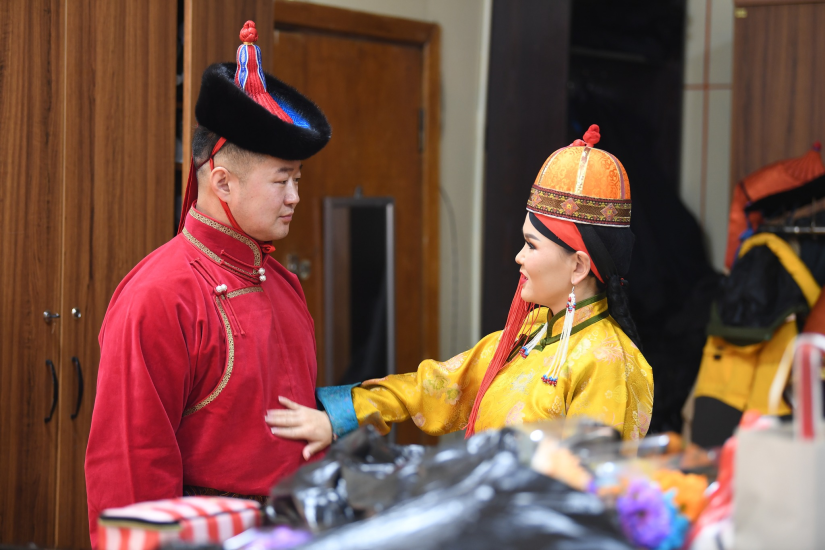
Long songs feature key elements called "Ai" [expression captivating the melody of a long song] and "Egshig Tomokh" [a set of rules for elongating vowels] You often say that "Ai" and "Egshig Tomokh" are the very spirit of the long song. So, what exactly gives the long song its beauty and that magical quality that makes it irresistible to sing?
The “Ai” is fundamental to long songs. Once the “Ai” is mastered, the beauty of the melody shines through. Otherwise, anyone can shout out sounds “aa, ii.” It is about finding the right place within the melody where the “Ai” naturally fits. My teacher used to say, “The “Ai” sits right within the melody of a song. It is felt only when you truly fall in love with the song. First, my son, learn to sing, learn to project your voice. If you truly fall in love with your singing, only then, consider yourself someone who will learn to sing long songs.” Genuine long song singers are able to visualize their experiences, then narrate them through their music. Let me give you an example with the song “Jaakhan Sharga” [Small Light Bay].
(Sings a part of “Jaakhan Sharga.”)
You see, you can feel that it is as though a question is being asked here.
(Performs again.)
Then comes a sort of prelude that answers: “What happened? Why?”
( The singer continues his performance.)
The “Ai” emerges in the part “Jaakhan”. When the “khan” part is articulated exquisitely, it becomes very pleasing to the ear. The “Shargaa” part is prolongedly held. The seamless connection of these two elements will make the song lively and can even touch those unfamiliar with long songs. For example, when you listen to the song "Jaakhan Sharga" by Honored Cultural Figure of Mongolia Lkhamjav Baatar, you can't help but think, "How beautiful!"
Traditional Mongol long songs are categorized into styles such as “Aizam,” “Shastir,” “Suman,” and “Besreg.” How do these styles differ from each other? And could you please explain while demonstrating?
“Aizam” [extended] long songs are characterized by expansive and resonant “Ai,” with melodies spanning over two octaves. Also, several “Aizam” songs do have a range of less than two octaves, but they are still distinguished by the flowing, continuous melody. In contrast, “Suman” [mediumlength] long songs may also cover two octaves but have less “Ai.” The “Suman” long songs are defined by their lively and interweaving melody, with balanced “Ai.”
Without acquiring the “Ai,” it can be hard to tell the difference between these two styles. One might end up singing two songs with different styles both in “Aizam,” or in “Besreg” styles. Moreover, the “Egshig Tomokh” is the core of “Aizam” long songs. For example, take the song called “Durvun Durvuljintei Zambuutiv” [Placid World with Four Squares].
(The singer demonstrates.)
It begins deep from within, and stirring,
(The singer demonstrates again.)
If you start like this, it sounds flat and empty. However, when you begin low and deep, the “Ai” comes across as rich and sonorous.
(The singer sings once again.)
In this case, the “Ai” would not ground as fumes of incense. If the singer keeps this pattern, he is regarded as an “Aizam” long-song singer.
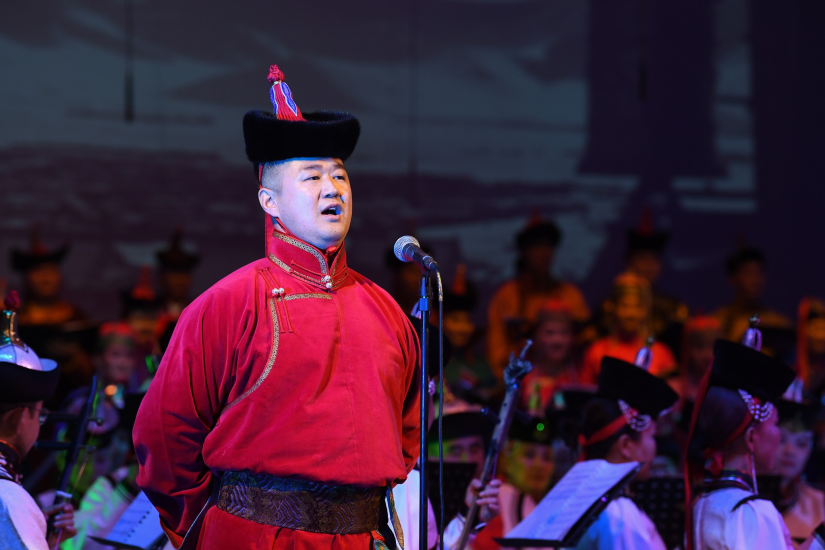
What about “Shastir” long songs?
“Shastir” [religious] long songs are tied to religious or philosophical themes. This style refers to the Bayanbaraat melody [eastern long-song style that dominates in Bayantsagaan and Mungunmorit soums of Tuv aimag, as well as Deren soum of Dundgobi aimag]. They cover a smaller range, and their melodies are lighter compared to other styles. “Shastir” long songs are often recited in a manner that resembles a sutra chant.
(Sings an example.)
This is how the Bayanbaraat melody sounds. On the other hand, Besreg [compact or shortened] long songs are briefer, with a range of just over an octave. They are characterized by delicate and quick melodic movements. Popular examples include “Tsombon Tuuraitai Khuren” [Brown Horse with Bud-Shaped Hooves], “Khuurkhun Khaliun” [Beautiful Yellow Dun], “Khuren Tolgoin Suuder,” [Shadow of the Brown Hill] and “Erdene Zasgiin Unaga,” [Foal of Erdene Zasag] and “Er Bor Khartsaga” [Brown Male Hawk].
(Sings a part of a Besreg long song.)
In the “Besreg” style, The “Egshig Tomokh” technique is applied swiftly. In contrast, “Aizam” songs would be like this.
(Sings again to demonstrate.)
In “Aizam” songs, the melody is stretched, with syllables highly elongated.
Which style do you perform most often? In which style do you feel most elated when singing?
As a Khalkha person from Setsen Khan aimag, I naturally draw toward the Khalkha melody. I strive to master other melodies as well. However, to take an example, singing in the Borjigin melody [an eastern longsong style popular in Dundgobi aimag] can only be performed by someone from the Borjigin lineage as the melody is deeply ingrained in the flesh, and imprinted in the heart from a very young age. I was born in the Central Khalkha region, so the Khalkha melody is haunted in my ears. One can imitate other melodies, but in that case, the essence of the song is lost. Although I am not a Borjigin, I can sing a Borjigin song, but it would just not carry the same soul and would sound like a cover version if said in modern language.
If a world-renowned opera singer were taught to sing traditional Mongol long songs, do you think they could capture the depth?
They would undoubtedly bring their own interpretation, but as I’ve mentioned before, the essence of long songs is embedded in the singer’s very being. It is deeply tied to their genetic heritage and upbringing. It can also be a matter of environment. I grew up in a rural area, which shaped my understanding and connection to these songs differently than someone raised in an urban environment. It is evident that we differ in social upbringing.
Traditional Mongol long songs are often intertwined with chronological events, romance, magnificent horses, and beautiful nature. Composers of these songs are unknown. Could we create new long songs as popular songs today?
Not long ago, a few composers like Dugarjav Magsarjav, Dorjdagva Jigzav, and Tsoodol Soli composed new long songs. One example is a beautiful song titled “Ulzii Tuvshin Uls” [Blessed Tranquil Country] composed by Mr. Tsoodol, with lyrics by poet Surenjav Sharav. My senior teacher, Battumur Dolgor, brought the song to life.
Renowned since ancient times, My abundant land of Kherlen - oh, indeed!
Blue like the eternal flame, With a horizon that extends so far away!
It was recorded in 1994 by teacher Tsoodol at the Mongolian Radio. It has a resonant melody.
Could you please recite a part of it?
(Sings “Ulzii Tuvshin Uls”)
How exquisite! You also excel in the traditional Mongol sport of knuckle-bone shooting. Many people around the world may not be familiar with it, but Mongol knuckle-bone shooting, along with the long song, is recognized by UNESCO as the Intangible Cultural Heritage of Humanity. How did you get into this unique tradition?
I developed an interest in knucklebone shooting in 2015. After three years of training, I earned the title of “State Sharpshooter” in 2018. Knuckle-bone shooting is one of the honored traditional games of the Mongols. It is impressive to hear the harmonious chants of the knucklebone shooting and the collective cheer of the crowd. This game talks with the heart and mind, testing one’s strength and courage. If you host a knuckle-bone shooting event in your place, it is believed that the livestock will thrive and multiply by thousands. It is truly a joyous and auspicious tradition.
The person sitting next to the “Zurkhai” [shooting board] plays a crucial role, guiding the teams with rhythmic chants to communicate the trajectory of the shots. For instance, if the aim is lower, the chant might sound like this:
(Performs a chant.)
If the aim is higher:
(Performs another chant.)
These chants help the shooter adjust and refine their focus. Essentially, the game itself is a dialogue, carried out through melody. During training sessions, teams practice not only shooting but also listening and attuning their ears to these guiding rhythms.
I once participated in the National Naadam Festival by making a bold promise to win to my boss, asking for a day off. At the time, I rarely missed the target and would often make it to the finals. In the finals, only a few khasaa [target bones put in rows on a small wooden structure called “Zurkhai”] remain. Missing means defeat and hitting ensures victory. I often found myself in these tense final rounds, but fortunately, I hit my targets. Our team ended up claiming a medal. I wore the medal proudly when I returned to work, and my colleagues were so happy for me.
Every nomadic Mongol tradition is related to each other. The melodic chants in knuckle-bone shooting are inherently linked to the spirit of long songs. Both long songs and knuckle-bone shooting bring mindfulness and require immense focus. One feels proud to be a Mongol when appreciating these Mongol traditions. However, modern society is often distracted by digital wonders like the internet or smartphones, distancing itself from these traditions. What message would you like to pass on to younger generations?
I wish every Mongol to sing our traditional long songs, much like the saying goes, “To have three songs at a feast and three wins at Naadam.” You don’t need to sing professionally. Our children or grandchildren would recall, “My father or mother was a long-song singer.” Just as Mongol households honor the Morin Khuur [a traditional Mongol musical instrument, Horsehead Fiddle] as a sacred symbol, I hope every Mongol knows three long songs by heart.
Thank you!
Please watch the interview through the link below.
https://youtu.be/MeqkfJolY-s?si=qs4aiYF3YpDyzsJn
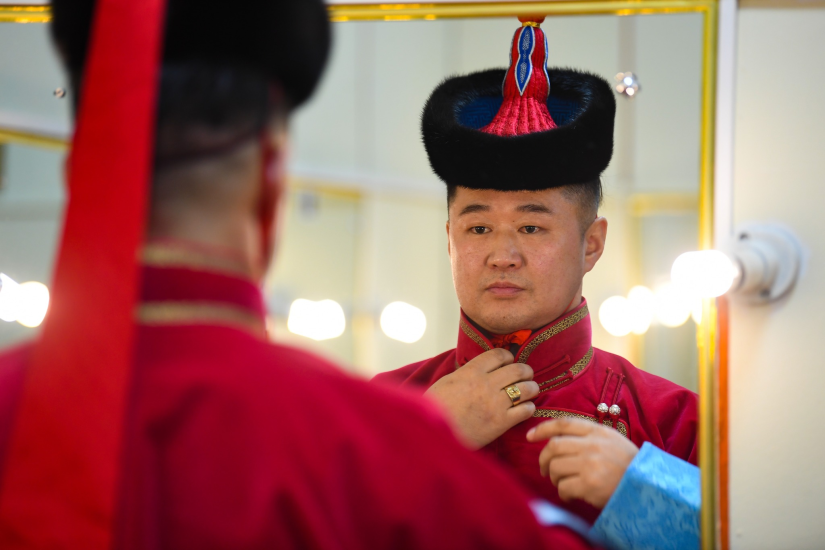
 Ulaanbaatar
Ulaanbaatar






